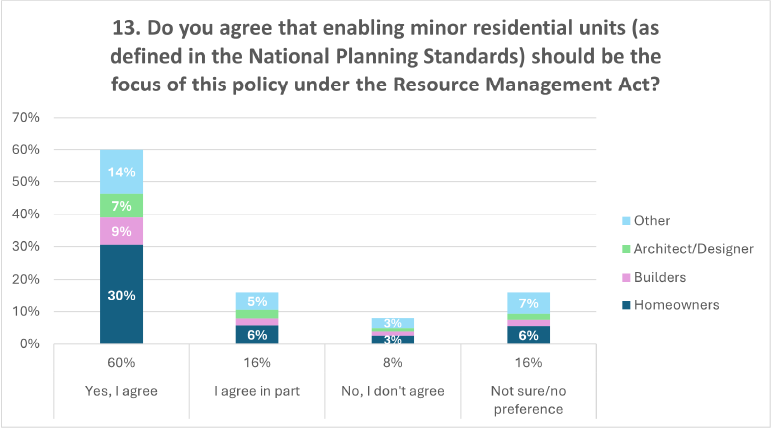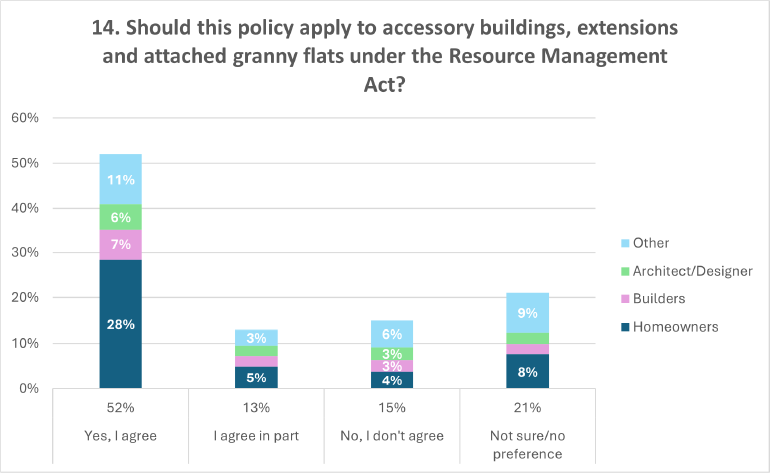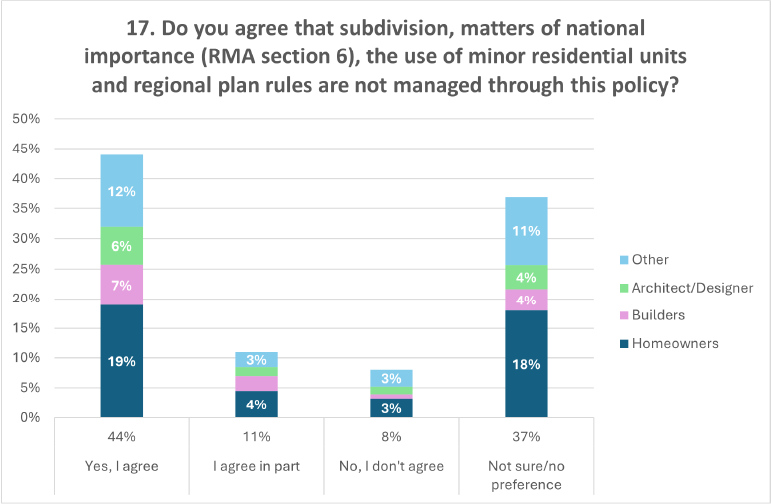Focus of the resource management proposal – scope of the policy under the Resource Management Act
On this page
What was proposed
The focus is to enable small, detached, self-contained, single storey houses for residential use i.e. a granny flat or minor residential unit (MRU).
Matters out of scope of the policy:
- Subdivision – must meet the subdivision requirements set out in the relevant district plan. Matters of national importance (Resource Management Act section 6 matters), such as significant natural areas, natural hazards, and historic heritage.
- The use of the minor residential units – district plans manage the activities.
- Regional plan rules – granny flats may require a resource consent under a regional plan, like wastewater discharge in rural areas.
What was asked
Question 13: Do you agree that enabling minor residential units (as defined in the National Planning Standards) should be the focus of this policy under the Resource Management Act?
Question 14: Should this policy apply to accessory buildings, extensions and attached granny flats under the Resource Management Act?
Question 17: Do you agree that subdivision, matters of national importance (Resource Management Act section 6), the use of minor residential units and regional plan rules are not managed through this policy?
Question 18: Are there other matters that need to be specifically out of scope?
Summary of feedback
Overall, 1450 submitters responded to questions 13, 14, and 17 which is reflected in Figures 8, 9 and 10 below. Question 18 is a free text only question. The number of submitters who responded with written responses is as follows:
- Question 13: 328
- Question 14: 390
- Question 17: 246
- Question 18: 142 (free text only question).
Most submitters were supportive of the proposal and thought that the focus of the policy on minor residential units is the right approach, with only some not agreeing.
Many submitters agreed with the questions of scope – that subdivision, matters of national importance, unit use, and regional rules should be out of scope, as proposed. Many submitters were not sure or did not have a preference. A few thought the scope should be widened to include one or more matters, with subdivision being the most raised matter. A few submissions, notably from councils, stated the scope should be wider to include other matters not expressly listed.
Nearly all submitters thought that accessory buildings should be included in the scope of the policy.
The written responses to questions 13, 14, 17, and 18 overlap and are therefore summarised jointly, below.
Figure 8: Graph detailing the response to question 13

Text description for graph - Figure 8: Graph detailing the response to question 13
Figure 9: Graph detailing the response to question 14

Text description of graph - Figure 9: Graph detailing the response to question 14
Figure 10: Graph detailing the response to question 17

Text description of graph - Figure 10: Graph detailing the response to question 17
Key themes
Minor, ancillary residential units as the focus for the policy
Most submissions agree that enabling minor residential units or granny flats as defined in the National Planning Standards is the appropriate focus of the policy. Keeping the policy focused on granny flats and not widening the scope ensures that the policy is simpler and should result in more granny flats being built more easily. Otherwise, without the proposed approach some submitters consider there is too much variability and therefore excessive cost to navigate the complexity and differences in granny flat development. Another reason submitters support the policy is it will offer more small housing types, which the market currently doesn’t provide enough of.
Some submitters, notably councils and the New Zealand Planning Institute, said that many district plans already enable granny flats and resource consents are often not required. There is also some concern that this policy will have a limited effect on housing problems in many cities that already have more enabling provisions and will only benefit people that already own a home.
Some submitters thought the size of the unit should not be limited to 60 square metres. They consider that if the site allows a bigger unit, then it should be allowed. They considered the effects of a smaller unit are similar to larger units where the land area allows for it.
A few submitters noted that exempting granny flats from district plans will impact the character and appearance of urban environments and felt that over time these impacts will be collectively significant and will have a negative outcome due to aesthetics and overcrowding.
Some councils questioned how a principal residential unit will be identified within the context of properties where there is more than one dwelling present.
Some submitters considered it would be beneficial to allow granny flats to be entirely independent of the main dwelling, not agreeing that it be in association with a principal dwelling unit. They considered the policy should allow the building of a small home where there is no existing principal residential unit on the site, or the building of multiple small homes on a larger site or a site that only has a single existing dwelling. Approximately 10 per cent of all submissions (nearly 200 submitters) want the policy to be more inclusive of tiny homes. Tiny homes are typically defined as small homes on wheels or that are semi-permanent and these are currently not provided for in most district plans.
Accessory buildings, extensions and attached granny flats
Most submitters supported the scope of the policy including ancillary buildings such as garages and sleepouts. Homeowners were the greatest supporter of including accessory buildings in the policy. Just over one third of submitters did not support the scope being so inclusive, mostly architects and designers; a total of 109 submitters.
Reasons for not supporting accessory buildings included overcomplicating the policy, or increased risk in terms of poor building quality. Some noted that accessory buildings are already generally permitted by district plans.
The question about whether granny flats could be attached to the principal dwelling drew some detailed responses. Some responses questioned why a resource management standard should manage a Building Code matter like building separation, where the rationale is to simplify construction and reduce the risk from fire spread. Some submitters thought this risk could be addressed with fire walls and without the need for a building consent. Many thought attached buildings are better for the occupants, especially those who are related and where there are care commitments involved. Some submitters also thought attached granny flats would be better from an urban character and appearance perspective. Submitters also said many sections will be too small to fit a standalone granny flat.
Use of the dwelling
Some submitters raised concerns with units being used for short-term rental such as Airbnb and visitor accommodation, citing that they either supported the scope not including these uses, or that the proposed policy should explicitly exclude them (therefore preventing district plans from allowing them) and the units should only be occupied by family of the property owners or principal unit occupiers. A few submitters said minor residential units should only be for rental accommodation to support the supply of rental housing generally.
Subdivision
Some submitters requested that subdivision should be included in the policy and not be left to the discretion of district plans. They have not seen strong evidence that minor residential units must have an ancillary role and believe that many people will be better served by the dwellings being as independent as possible from the main dwelling.
Some submitters, including councils, considered the policy should not override local subdivision rules, otherwise each new lot would allow a granny flat. Some councils were concerned that the terminology of "granny flat” will not fit the definition used in their district plan which could cause unintended consequences. Councils are also concerned that, as landowners or circumstances change over time, there will be an expectation that the site where the granny flat is developed could be subdivided, regardless of whether this policy includes it in scope or not. To avoid this, they considered the policy should be clear that granny flats need to comply with district plan requirements if an application for subdivision is made in the future.
A few point out that, in their view, expressly allowing subdivision will require separate services, which will require additional permissions including a building consent.
Matters of national significance (Resource Management Act, section 6 matters) and regional plan rules
Most submitters supported the proposal to exclude matters of national significance from the policy proposal. They said that councils must be able to implement and keep overlays relating to natural hazards, significant natural areas, the relationship of Māori and their culture and traditions with their ancestral lands, waters, sites, wāhi tapu, and other taonga and historic heritage, for example. Even where some submitters considered matters of national significance can unreasonably limit development at times, some say it is not appropriate for the granny flat proposal to override this section of the Resource Management Act.
The Natural Hazards Commission Toka Tū Ake note that excluding section 6 of the Resource Management Act section 6 will mean the natural hazards provisions of existing district plans will be the only way to manage the location of granny flats to ensure they are not constructed in areas subject to natural hazards.
Some submitters commented that regional plan rules should be out of scope to ensure matters such as discharge of wastewater to the land (septic tanks), which would affect neighbours and the environment, are not permitted. A few submitters thought that granny flats will be difficult to achieve in unconnected rural areas if they must obtain a discharge resource consent.
Additional matters out of scope
Most responses to the question listed matters that were already proposed to be out of scope of the policy.
Some thought limitations around servicing, including water and wastewater, should be out of scope too, meaning granny flats could be restricted where there are servicing limitations. Other matters raised include contaminated soil and buffer areas around wastewater treatment plans and airports.

